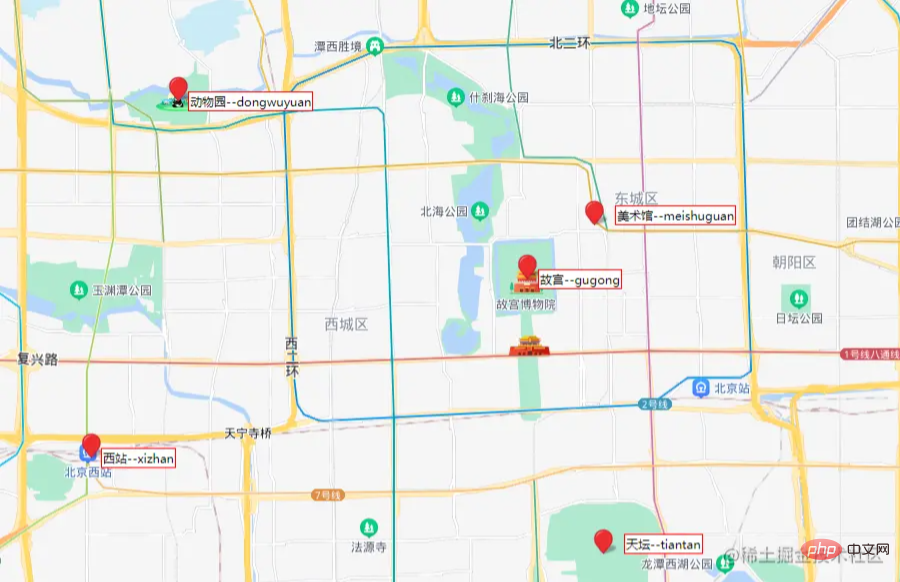GEO is a new geographical location module added to Redis after version 3.2. This article will take you through the GEO geographical location module. I hope it will be helpful to you!

GEO is a new geographical location module added to Redis after version 3.2, which means that Redis can be used to implement nearby location functions. [Related recommendations: Redis video tutorial]
The general method is to pass A rectangular area is used to limit the number of elements, and then the full distance calculation is performed on the elements in the area and then sorted. This can significantly reduce the amount of calculation.
select id from positions where x0-r < x < x0+r and y0-r < y < y0+r
In order to increase performance, the above SQL needs to add a two-way composite index to the latitude and longitude coordinates. However, database query performance is limited after all. If it is used in high concurrency situations, this may not be a good solution.
GeoHash algorithm, and Redis also uses GeoHash algorithm. GeoHash The algorithm maps two-dimensional longitude and latitude data to one-dimensional integers , so that all elements will be mounted on a line, close to each other The distance between points after mapping two-dimensional coordinates to one dimension will also be very close. When we want to calculate "people nearby", we first map the target position to this line, and then obtain nearby points on this one-dimensional line. GeoHash The algorithm will continue to do this integer oncebase32 Encoding(0-9,a-z remove the four letters a,i,l,o) becomes a string. zset. The value of zset is the # of the element. ##key, score is the 52-bit integer value of GeoHash. . By sorting score of zset, you can get other elements near the coordinates (the actual situation is more complicated, but this is enough to understand), and by restoring score to The coordinate value can be used to obtain the original coordinates of the element. 
##1. Add geoaddgeoadd key longitude latitude member [longitude latitude member ...]
127.0.0.1:6379> geoadd beijing 116.403856 39.924043 gugong
(integer) 1
127.0.0.1:6379> geoadd beijing 116.343620 39.947633 dongwuyuan
(integer) 1
127.0.0.1:6379> geoadd beijing 116.328643 39.900272 xizhan 116.415324 39.931231 meishuguan 116.416852 39.887607 tiantan
(integer) 3
using zset
2. Distance geodistgeodist key member1 member2 [unit]
127.0.0.1:6379> geodist beijing gugong xizhan km
"6.9402"
127.0.0.1:6379> geodist beijing gugong dongwuyuan # 默认单位m
"5768.5737"
127.0.0.1:6379> geodist beijing xizhan xizhan
"0.0000"
3. Location geoposgeopos key member [member ...]
127.0.0.1:6379> geopos beijing gugong
1) 1) "116.4038559794426"
2) "39.92404192186725"
127.0.0.1:6379> geopos beijing tiantan xizhan
1) 1) "116.41685396432877"
2) "39.887607839922914"
2) 1) "116.32864147424698"
2) "39.900271306834973"
4. Hash value geohashgeohash key member [member ...]
127.0.0.1:6379> geohash beijing gugong
1) "wx4g0gfwqk0"
encoding, you can directly find the latitude and longitude through http://geohash.org/wx4g0gfwqk0
1. Query ireader
Range20 The maximum number of elements within 3 kilometers are sorted by distance. , it will not exclude itself (use desc when using inversion)
127.0.0.1:6379> georadiusbymember company ireader 20 km count 3 asc 1) "ireader" 2) "juejin" 3) "meituan"
2. Three optional parameters withcoord withdist withhash are used to carry additional parameters, withdist is very useful, it can be used to display distance
georadiusbymember key member radius m|km|ft|mi [WITHCOORD] [WITHDIST] [WITHHASH] [COUNT count] [ASC|DES]
127.0.0.1:6379> georadiusbymember beijing gugong 5 km withcoord withdist withhash count 3 asc
1) 1) "gugong"
2) "0.0000"
3) (integer) 4069885568932443
4) 1) "116.4038559794426"
2) "39.92404192186725"
2) 1) "meishuguan"
2) "1.2634"
3) (integer) 4069885710390435
4) 1) "116.41532510519028"
2) "39.93123039107514"
3) 1) "tiantan"
2) "4.2014"
3) (integer) 4069885398502557
4) 1) "116.41685396432877"
2) "39.887607839922914"3. Query nearby elements based on coordinate valuesgeoradius key longitude latitude radius m|km|ft|mi [WITHCOORD] [WITHDIST] [WITHHASH] [COUNT count] [ASC|DES]
127.0.0.1:6379> georadius beijing 116.383882 39.922061 5 km withcoord withdist withhash count 3 asc
1) 1) "gugong"
2) "1.7180"
3) (integer) 4069885568932443
4) 1) "116.4038559794426"
2) "39.92404192186725"
2) 1) "meishuguan"
2) "2.8693"
3) (integer) 4069885710390435
4) 1) "116.41532510519028"
2) "39.93123039107514"
3) 1) "dongwuyuan"
2) "4.4588"
3) (integer) 4069879836419688
4) 1) "116.34361892938614"
2) "39.94763257169722"Notes
zset collection. In the Redis cluster environment, the collection may be migrated from one node to another node. If the data of a single key is too large, it will have a greater impact on the migration work of the cluster. In a cluster environment, a single key The corresponding data volume should not exceed 1M, otherwise it will cause lags in cluster migration and affect the normal operation of online services.
So, it is recommended that Geo data be deployed using a separate Redis instance instead of a cluster environment.
If the amount of data exceeds 100 million or even larger, the Geo data needs to be split, split by country, province, city, even in very populous cities. Can be split by zone. This can significantly reduce the size of a single zset set.
For more programming related knowledge, please visit: Programming Video! !
The above is the detailed content of Let's talk about the GEO geographical location module in Redis. For more information, please follow other related articles on the PHP Chinese website!
 Commonly used database software
Commonly used database software
 What are the in-memory databases?
What are the in-memory databases?
 Which one has faster reading speed, mongodb or redis?
Which one has faster reading speed, mongodb or redis?
 How to use redis as a cache server
How to use redis as a cache server
 How redis solves data consistency
How redis solves data consistency
 How do mysql and redis ensure double-write consistency?
How do mysql and redis ensure double-write consistency?
 What data does redis cache generally store?
What data does redis cache generally store?
 What are the 8 data types of redis
What are the 8 data types of redis